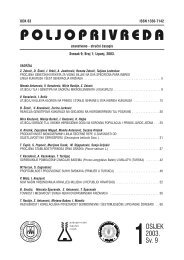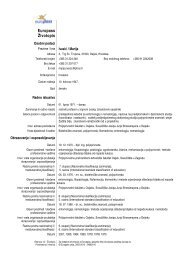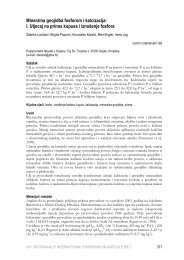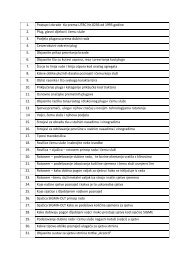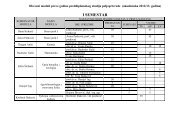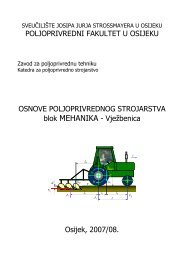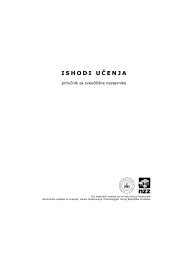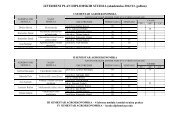Poljoprivreda 2-2006 final.qxd
Poljoprivreda 2-2006 final.qxd
Poljoprivreda 2-2006 final.qxd
Create successful ePaper yourself
Turn your PDF publications into a flip-book with our unique Google optimized e-Paper software.
Z. Tolušić et al.: GAME MEAT MARKET IN EASTERN CROATIA<br />
61<br />
al. (2002) found out that people (e.g. hunters) who frequently<br />
consume meat originating from game killed with<br />
lead shot, did not have any risk of blood lead increase.<br />
The most of examinees (90%) think that game<br />
meat was healthier to consume if originating from animals<br />
hunted in their natural environment, than if intensively<br />
produced on specialized farms. As natural habitats<br />
of wild animals are constantly being reduced, especially<br />
in developing countries, raising of game animals on<br />
farms is becoming more popular particularly in Germany<br />
and Sweden, which have the biggest population of<br />
intensively produced game animals in Europe. On the<br />
other hand, on New Zealand, population of deers raised<br />
on farms exceeds one million, which takes up approximately<br />
one half of all farm produced game animals in the<br />
world. At the same time, New Zealand is the biggest<br />
world exporter of game meat, followed by Argentina,<br />
Australia, Poland and some other countries of Middle<br />
and East Europe. The biggest import market is the<br />
European Union, especially Germany, France, Italy and<br />
Sweden (Krostitz, 1996). Inhabitants of Eastern Croatia<br />
are aware of potentials of intensive game production on<br />
specialized farms (78%), however such production is in<br />
Croatia still in its roots.<br />
Taking into consideration the fact that in Croatia a<br />
yearly consumption of game meat amounts to only 0.55<br />
kg per household member, being 1% of total meat consumption,<br />
there is an obvious gap between number of<br />
hunted game and amount of meat consumed. A probable<br />
explanation for such situation is that only small<br />
amount of meat reaches the market and the rest is kept<br />
by hunters. Similar situation is observed in Germany,<br />
where game meat consumption also takes up only 1% of<br />
a total meat consumption (Bandik and Ring, 1996), irrespective<br />
of the fact that Germany is one of the biggest<br />
importers of game meat in the European Union (Krostitz,<br />
1996). There is an additional complication with marketing<br />
of game meat in Croatia, referring to the strict veterinary-hygienic<br />
regulations, and lack of facilities for processing<br />
and storage of game meat. Because of that, it is<br />
not surprising that on Croatian market there are supplies<br />
of imported frozen game meat, for example deer loin<br />
from New Zealand, rabbit from Italy, etc.<br />
Žlender and Čepin (2003) stated that, besides climatic<br />
conditions in which game is raised, its meat quality<br />
depended on processing and production, which, if<br />
traditionally performed, have marketing advantage.<br />
Eastern Croatia is a region known by its traditional meat<br />
processing and home made meat products. When preparing<br />
cured meat products (special Slavonian meat<br />
specialty called “kulen”, sausages, etc.), people tend to<br />
add game meat to pig meat in order to improve its culinary<br />
characteristics (the most added is wild boar meat,<br />
sometimes deer and roe deer meat). Such home made<br />
meat products are usually consumed by producers<br />
themselves, while there are industrially produced goods<br />
(eg. “kulen” of game meat) offered on the market, but<br />
still in negligible amounts. Eastern Croatia needs to<br />
recognize its advantages with respect to traditional<br />
meat processing, and to promote them to a distinguished<br />
marketing brand.<br />
Product pricing plays an important role in marketing<br />
policies. In Croatia, price of game meat exceeds<br />
price of domesticated meat. The same happens in the<br />
EU countries (Krostitz, 1996). Although the majority of<br />
questioned people considers game meat as healthy<br />
food. Results show that game meat is being bought by<br />
only 22%, and 51% think such meat was too expensive.<br />
Expensiveness is the main reason why consumers have<br />
such meat only once a month (51%). Taking into consideration<br />
monthly income of their respective household,<br />
58% of examinees can afford to buy game meat only<br />
once a month, and, if having an opportunity, they would<br />
opt for roe deer (55%) and rabbit (25%). Most of examinees<br />
(56%) is convinced that it would be possible to<br />
improve market of game meat by lowering of prices.<br />
About 27% think this could be achieved by opening of<br />
specialty stores, however, if considering previously presented<br />
data on game meat consumption and prices, this<br />
would not be a wise recommendation for the time being.<br />
The least number of examinees (17%) believes that<br />
game meat market can be stimulated through more<br />
aggressive marketing activities (Figure 3.).<br />
Figure 3. Possibilities of game meat market<br />
improvement<br />
Grafikon 3. Mogućnosti poboljšanja tržišta mesa<br />
divljači<br />
A significant public health issue in Eastern Croatia<br />
is a parasitic disease called trichinelosis, the consequences<br />
of which fear some 78% of examinees. A cause<br />
of this dangerous zoonosis is a parasitic nematode<br />
Trichinella sp., attacking domestic pigs, but can be also<br />
found in game meat, especially in meat of wild boar,<br />
badger, bear, and other omnivores. 73% of examinees<br />
are aware of these facts. The Republic of Croatia requires<br />
obligatory veterinary inspection of meats from risk<br />
groups, so their consumption is safe, which is also proven<br />
by 78% of those who trust the results of veterinary<br />
tests. It can be said that this disease does not have any<br />
negative impact on the game meat market in Eastern<br />
Croatia.<br />
POLJOPRIVREDA 12:<strong>2006</strong> (2) 58-63



